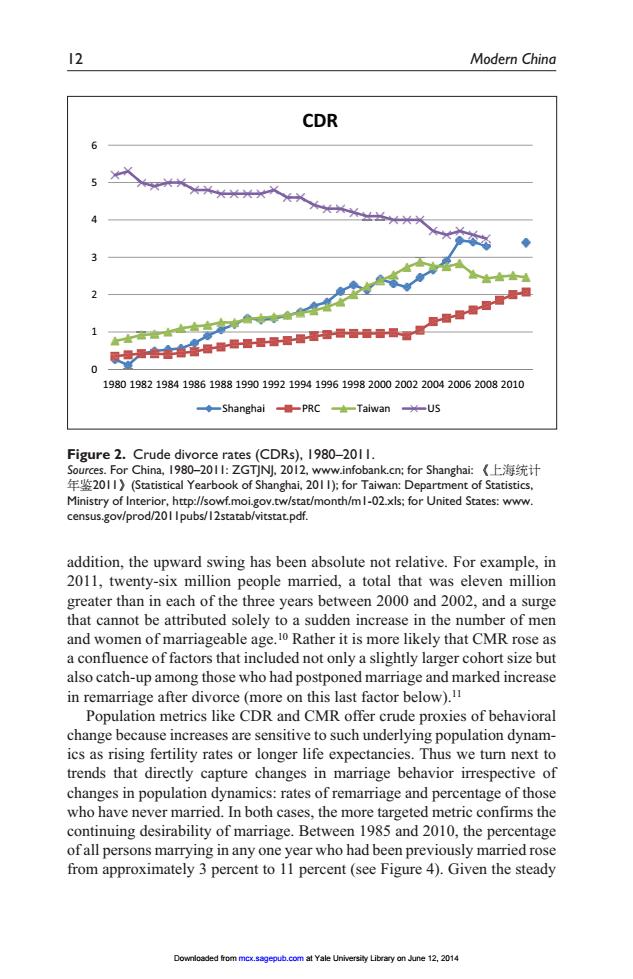正在加载图片...

12 Modern China CDR 6 1980198219841986198819901992199419961998200020022004200620082010 ◆-5 hanghai0-PRC☆-TaiwanU5 Figure 2.Crude divorce rates(CDRs),1980-2011. Sources..For China,I980-20ll:ZGTJN,20I2,www.infobank.cn:for Shanghai:《上海统计 2011)(Statistical Yearbook of Shanghai,201 1):for Taiwan:Department of Statistics. Ministry of Interior,http://sowf.moi.gov.tw/stat/month/mI-02.xls:for United States:www. census.gov/prod/201 Ipubs/12statab/vitstat.pdf. addition,the upward swing has been absolute not relative.For example,in 2011,twenty-six million people married,a total that was eleven million greater than in each of the three years between 2000 and 2002,and a surge that cannot be attributed solely to a sudden increase in the number of men and women of marriageable age.10 Rather it is more likely that CMR rose as a confluence of factors that included not only a slightly larger cohort size but also catch-up among those who had postponed marriage and marked increase in remarriage after divorce(more on this last factor below).1 Population metrics like CDR and CMR offer crude proxies of behavioral change because increases are sensitive to such underlying population dynam- ics as rising fertility rates or longer life expectancies.Thus we turn next to trends that directly capture changes in marriage behavior irrespective of changes in population dynamics:rates of remarriage and percentage of those who have never married.In both cases,the more targeted metric confirms the continuing desirability of marriage.Between 1985 and 2010,the percentage of all persons marrying in any one year who had been previously married rose from approximately 3 percent to 11 percent(see Figure 4).Given the steady Downloaded from mex.sagepub.com at Yale University Library on June 12,201412 Modern China addition, the upward swing has been absolute not relative. For example, in 2011, twenty-six million people married, a total that was eleven million greater than in each of the three years between 2000 and 2002, and a surge that cannot be attributed solely to a sudden increase in the number of men and women of marriageable age.10 Rather it is more likely that CMR rose as a confluence of factors that included not only a slightly larger cohort size but also catch-up among those who had postponed marriage and marked increase in remarriage after divorce (more on this last factor below).11 Population metrics like CDR and CMR offer crude proxies of behavioral change because increases are sensitive to such underlying population dynamics as rising fertility rates or longer life expectancies. Thus we turn next to trends that directly capture changes in marriage behavior irrespective of changes in population dynamics: rates of remarriage and percentage of those who have never married. In both cases, the more targeted metric confirms the continuing desirability of marriage. Between 1985 and 2010, the percentage of all persons marrying in any one year who had been previously married rose from approximately 3 percent to 11 percent (see Figure 4). Given the steady 0 1 2 3 4 5 6 1980 1982 1984 1986 1988 1990 1992 1994 1996 1998 2000 2002 2004 2006 2008 2010 CDR Shanghai PRC Taiwan US Figure 2. Crude divorce rates (CDRs), 1980–2011. Sources. For China, 1980–2011: ZGTJNJ, 2012, www.infobank.cn; for Shanghai: 《上海统计 年鉴2011》(Statistical Yearbook of Shanghai, 2011); for Taiwan: Department of Statistics, Ministry of Interior, http://sowf.moi.gov.tw/stat/month/m1-02.xls; for United States: www. census.gov/prod/2011pubs/12statab/vitstat.pdf. Downloaded from mcx.sagepub.com at Yale University Library on June 12, 2014